AP Psych Unit 2 Part 1: Cognition
1/47
Earn XP
Description and Tags
Name | Mastery | Learn | Test | Matching | Spaced |
|---|
No study sessions yet.
48 Terms
Selective Attention
Bottleneck Theories of Selective Attention: We have a limited capacity to attend to stimuli. There is no limit to how much stimulation can be present. Selective Attention allows us to select what to attend to
Cocktail Party Phenomenon
The ability to focus one's listening attention on a single talker among a mixture of conversations and background noises, ignoring other conversations. Then if someone over the other side of the party room calls out our name suddenly, we also notice that sound and respond to it immediately.
Inattentional Blindness
Not seeing objects when our attention is directed elsewhere. The focus on one detail makes us miss other obvious details
Change blindness
Not noticing changes in the environment.
Bottom-up Processing (Simplistic Processing)
A progression from individual elements to the whole. Also called data-driven processing. Perception must be largely data-driven because it must accurately reflect events in the outside world. The information is determined mainly be information from the senses (not from your expectations)
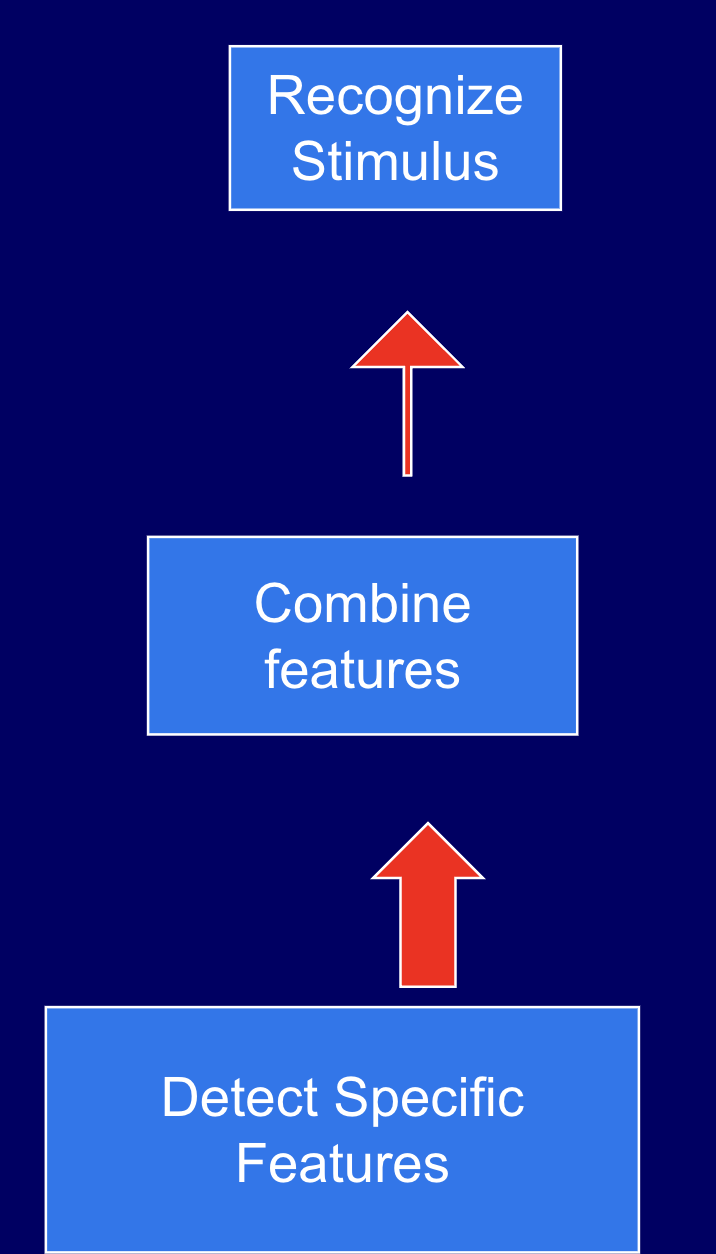
Top-Down Processing (Complex Processing)
A progression from the whole to the elements. Also known as schema-driven processing. In many situations your knowledge or expectations (or schemas) will influence your perception. In this case a schema is a pattern formed earlier in your experiences. Top-down occurs when a higher level concept influences your interpretation of lower level data. Set or expectancy demonstrate top-down processing

Principles of Perceptual Organization: Figure Ground
Visual image on what is in the front (figure) or in the background (ground)
List the Gestalt Principles of Grouping
Proximity, Similarity, Continuity
Gestalt Principles of Grouping: Proximity
Objects close together are perceived as being in the same group
Gestalt Principles of Grouping: Similarity
Similar in appearance seen as being in the same group
Gestalt Principles of Grouping: Continuity
Arranged in a continuous line appear to be in the same group
Gestalt Principles of Grouping: Closure
Similar to top down processing. Objects in a recognizable image are like to be perceived as belonging even if there are gaps the mind has to close
Perception of Depth and Distance
Use this to see how near or far objects are. Without it the world would be seen as flat or 2 dimensional
Visual Cliff study by Eleanor Gibson
See if a child will crawl over a cliff (glass table) to see if a child as acquired depth perception

List and Explain Monocular Cues: Linear, Interposition, Texture Gradient
Depth cues that do not depend on 2 eyes
Linear cues: Lines drawn like a railroad track
Interposition: Objects that block the view to other objects must be closer
Texture Gradient: Details in texture close to us but not far away
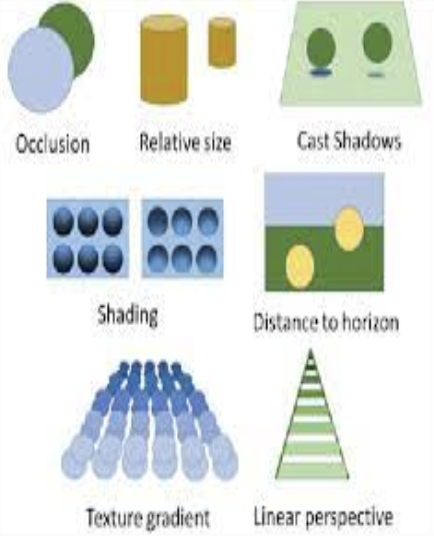
List and Explain Binocular Cues: Retinal Disparity
Depth cues that depend on having 2 eyes
Retinal Disparity (binocular disparity): Left and right fields of vision provide slightly different visual images when focusing on a single object. Used for depth and distance
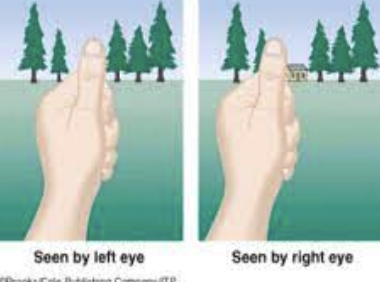
Perception of Motion: Stroboscopic Effect
Flip book effect where still images appear to move
Perception of Motion: Phi Phenomenon
Light Bulbs appear to be moving like Christmas lights
Perception of Motion: Autokinetic Effect
Spotlight on a wall that appears to move when you stare long enough
Perceptual Set
Predisposition to perceive things in a certain way. Expectation to see items one way. Involves top down processing and cues
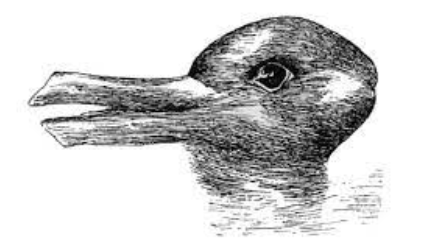
Perceptual Constancy: Size
Objects closer to our eyes produce a bigger image to our retina, but we use knowledge of the object to keep size constant
Perceptual Constancy: Shape
Objects viewed from different angles produce different shapes on the retina, use knowledge to keep the shape constant
Perceptual Constancy: Brightness
Perceive as a constant color even as light reflects off the object changes (daylight, bright lights, etc)
Natural Concepts
Mental classifications from our lives. Not precise. Create prototypes (ideal image). How we view the world individually.
Artificial Concepts
Set rules: Dictionary, Math rules, Science rules
Metacognition
Thinking about thinking: When we review how we did on something and reflect on our progress
Prototype
Images of what best fits categories
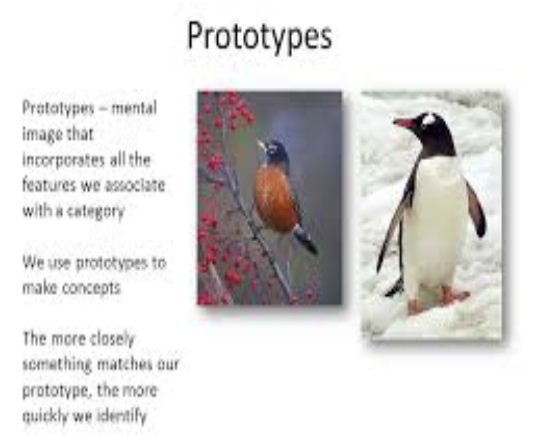
Schema
Concepts to organize and interpret information. Based on what we think things are like in the world
Perceptual Set
Predisposition to see things a certain way
Trial and Error
Try it until you get it
Intuition
Understanding something without conscious awareness: Gut feeling
Framing Problems
How a problem is presented can alter your perception
Bias
Can be done in a way to negatively or positively impact your thinking: “90% of people saw success”, “Order now before it’s all gone”
Algorithms
Step by step procedures that guarantee a solution, but time consuming
Heuristics
Simple thinking strategy that allows us to make judgments and solve efficiently. Quicker than algorithms, but can produce more errors
Availability Heuristic
Bases our judgments on how mentally available info is. “pop into mind” quickly. Recency, vividness and distinctiveness can increase the chances. Fresh in mind so influences how we feel
Representative Heuristics
Judging the likelihood of things in terms of how well they match prototypes (stereotype, or based on past experiences.
Ex. A man w/ a smoking pipe, has a book w/ him, and a beard. Is he more likely to be a truck driver or a professor
Heuristic error! Is a truck driver because there are more people employed in that profession
Insight
Sudden realization of a solution. Frontal lobe is for focused attention and then right temporal lobe would flash on an MRI
Working Backward
Backward working to find the solution to the problem. Know the answer figure out the path to get to it
Confirmation Bias
Type of cognitive bias in which people tend to seek out info which agrees w/ previously held beliefs. Give more weight to info which supports their beliefs, while discarding contradictory information
Curses / Good luck charms
Conspiracy theories
Lunar effect
Astrology
“Alternative” health practices
ESP
Fixation
The inability to see a problem from a fresh perspective.
Functional Fixedness (Love to test on this)
Tendency to view physical objects in terms of their traditional uses
Mental Set
Tendency to use past successful or unsuccessful solutions when faced with a new problem
Overconfidence
Tendency to overestimate the accuracy of our knowledge or judgments. Think a paper will only take a few hours when it takes a few days. We don’t learn much from these mistakes
Belief perseverance
Sticking to our initial bias even after it’s been shown to be incorrect. Creates social conflict. Hard to get people to change their minds even when presented w/ evidence
Gambler’s Fallacy
The mistaken belief that the likelihood of a random event is influenced by previous outcomes. People assume that is something happens frequently in the past, it will occur less frequently in the future.
Sunk Cost Fallacy
Tendency to continue investing time, money, or effort into something simply because you’ve already invested in it, even when it would be better to stop.
Study Guide Term Summary
Research Methods Questions
Research methods in psychology include descriptive, correlational, and experimental approaches, each with distinct benefits and limitations. Experimental methods focus on causation, utilizing independent and dependent variables. Descriptive methods involve case studies, surveys, and naturalistic observation, while correlational studies look at relationships between variables without determining causation.
Perceptual Set
Perceptual set refers to a predisposition to perceive things a certain way based on expectations or prior experiences. This “readiness to perceive” can influence how we interpret ambiguous stimuli, often leading us to see what we expect rather than what is objectively there.
Mental Set
A mental set is the tendency to approach problems using solutions that have worked previously. This can limit creative problem-solving by encouraging reliance on familiar methods, which may not be effective for new or unique challenges.
Schemas
Schemas are cognitive frameworks that help us organize and interpret information. These mental structures are based on past experiences and can affect perception, memory, and judgment, guiding us in understanding and predicting the world.
Bottom-Up and Top-Down Processing
Bottom-up processing is when perception begins with sensory input and builds up to a final representation, relying heavily on sensory data. Top-down processing involves using prior knowledge, context, and experience to interpret sensory information, affecting how we perceive objects and situations.
Attention Types
Different types of attention include selective attention (focusing on one stimulus), divided attention (multi-tasking across several stimuli), and sustained attention (maintaining focus over time). Each type has distinct implications for cognitive load and information processing.
Size, Color, and Shape Constancy, Perceptual Constancy
Perceptual constancy refers to our ability to perceive objects as unchanging in size, color, or shape, despite changes in perspective, lighting, or distance. For example, size constancy allows us to recognize a car as the same size, whether it's nearby or far away.
Depth and Distance Perception
Depth and distance perception help us judge spatial relationships and navigate the world. Depth cues give us information about an object’s distance, helping us perceive a three-dimensional world accurately.
Monocular and Binocular Cues
Monocular cues (available to one eye) and binocular cues (requiring both eyes) provide information about depth and distance. Monocular cues include linear perspective and interposition, while binocular cues rely on retinal disparity and convergence.
Gestalt Principles of Grouping
Gestalt principles describe how we naturally group visual elements, helping us make sense of complex stimuli. These principles include proximity (grouping nearby items), similarity (grouping similar items), continuity, and closure (filling in gaps to create a whole).
Priming
Priming occurs when exposure to one stimulus influences the response to another, often related stimulus. For example, hearing a related word can make you recognize or respond to another word faster.
Inattentional Blindness
Inattentional blindness is the failure to notice an unexpected object or event when focused on another task. This phenomenon shows how selective attention can limit our awareness of the full visual field.
Insight
Insight is a sudden realization of a problem's solution, often described as an "aha" moment. This process involves a restructuring of mental representations and can lead to novel problem-solving.
Accommodation and Assimilation
In cognitive development, assimilation involves incorporating new information into existing schemas, while accommodation requires modifying schemas when new information doesn’t fit.
Heuristics
Heuristics are mental shortcuts that simplify decision-making, often leading to quick, though sometimes inaccurate, judgments. Examples include the availability heuristic and representativeness heuristic.
Problem Solving
Problem-solving involves cognitive processes for finding solutions to challenges. Methods can include algorithms (step-by-step procedures), heuristics, and insight.
Algorithms
An algorithm is a systematic, logical rule or procedure that guarantees solving a particular problem if followed correctly.
Divergent and Convergent Thinking
Divergent thinking is a form of creativity that generates multiple potential solutions, while convergent thinking narrows down those options to the best solution.
Functional Fixedness
Functional fixedness is a cognitive bias that limits the use of an object to its typical function, which can hinder problem-solving by preventing creative use of objects.
Hindsight Bias
Hindsight bias is the "I knew it all along" effect, where people believe they could have predicted an outcome after it has happened.
Confirmation Bias
Confirmation bias involves seeking information that confirms existing beliefs and ignoring contradictory evidence, impacting critical thinking and objective analysis.
Prototype
A prototype is the best or most typical example of a category. It helps us quickly categorize new information based on how closely it resembles the prototype.
Metacognition
Metacognition is the awareness and understanding of one's own thought processes, including the ability to monitor and regulate cognitive activities.
Overconfidence
Overconfidence is a bias in which people overestimate the accuracy of their knowledge or judgments, often leading to errors.
Gambler's Fallacy
The gambler's fallacy is the mistaken belief that future probabilities are altered by past events, such as thinking a coin is "due" for heads after multiple tails.
Sunk Cost Fallacy
The sunk cost fallacy is the tendency to continue an endeavor due to previously invested resources, even if it no longer makes rational sense. This bias highlights the impact of prior commitment on decision-making.